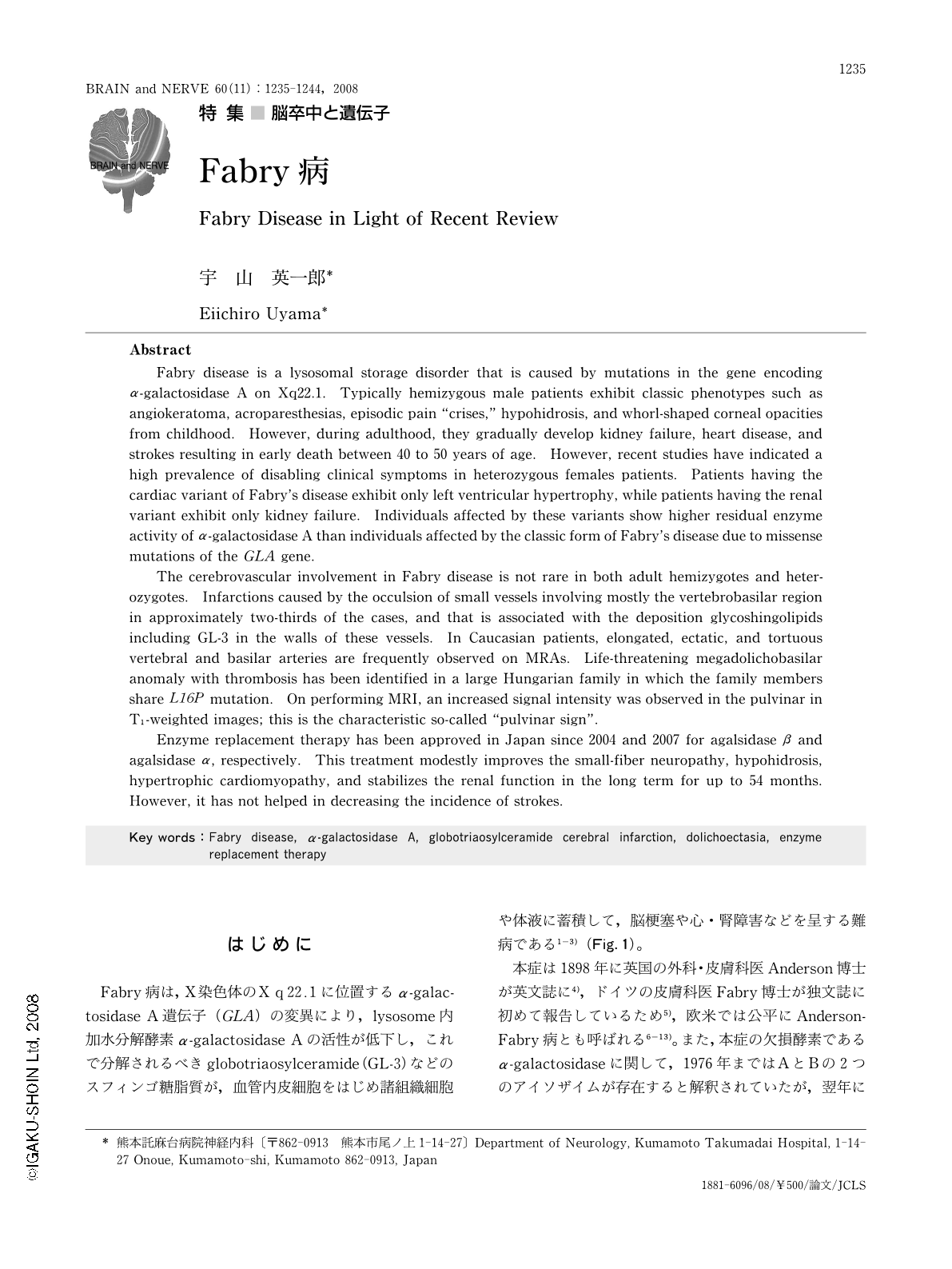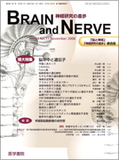Japanese
English
- 有料閲覧
- Abstract 文献概要
- 1ページ目 Look Inside
- 参考文献 Reference
はじめに
Fabry病は,X染色体のXq22.1に位置するα-galactosidase A遺伝子(GLA)の変異により,lysosome内加水分解酵素α-galactosidase Aの活性が低下し,これで分解されるべきglobotriaosylceramide(GL-3)などのスフィンゴ糖脂質が,血管内皮細胞をはじめ諸組織細胞や体液に蓄積して,脳梗塞や心・腎障害などを呈する難病である1-3)(Fig.1)。
本症は1898年に英国の外科・皮膚科医Anderson博士が英文誌に4),ドイツの皮膚科医Fabry博士が独文誌に初めて報告しているため5),欧米では公平にAnderson-Fabry病とも呼ばれる6-13)。また,本症の欠損酵素であるα-galactosidaseに関して,1976年まではAとBの2つのアイソザイムが存在すると解釈されていたが,翌年にα-galactosidase Bの実体はα-N-acetylgalacto- saminidaseであり,酵素蛋白質や遺伝子支配もα-galactosidase Aとは異なることが明らかにされた14,15)。さらに,このα-N-acetylgalactosaminidase遺伝子の異常で生じる疾患は,Schindler病とされ,1型:乳児期発症の神経軸索ジストロフィー,2型(神崎病):成人期発症のび漫性被角血管腫と軽度知能障害,3型:1型と2型の中間的病像に分類されている16-20)。したがって最近,本邦ではFabry病の欠損酵素をα-galaclosidaseと表記する傾向にあるが21),欧米では従来通りα-galaclosidase Aが用いられている1-6)。
Fabry病はこれまでX染色体連鎖劣性遺伝の形式をとり,ヘミ接合体の男性患者は古典的病像を呈し,保因者の女性にはLyonの仮説が適応されてきた。しかし,本遺伝形式をとるほかの疾患に比べ,ヘテロ接合体の女性も高頻度に発病するため,本症ではこれを保因者と呼ぶべきではない22)との意見や,遺伝形式は単にX染色体連鎖性と呼ぶのが正しいとの見解も出ている23,24)。したがって,特定疾患の公費申請時や酵素補充療法25,26)の選択の際には,女性患者も対象になることを再認識すべきである。
本症は従来,神経内科や脳神経外科領域では,若年性の脳梗塞をきたす単一遺伝子病の1つで,稀な疾患として知られてきたが,近年では酵素補充療法25,26)や亜型“心型Fabry病”27-29)の確立により,循環器領域で関心が高まっている。また“腎型Fabry病”30)の存在や,慢性腎臓病(CKD)の治療可能な原因の1つとして,腎臓内科・泌尿器科の分野でも啓蒙されている3,31-34)。発症頻度は人口4万人に1人とされ,世界で5,000例以上,本邦で1,000例以上の存在が推計されている21)。最近の調査では,成人発症の特発性肥大型心筋症の6.3%,18~55歳の全潜在性脳卒中患者の1.2%,腎不全の全透析患者の0.16~1.2%がFabry病とされている35)。
Abstract
Fabry disease is a lysosomal storage disorder that is caused by mutations in the gene encoding α-galactosidase A on Xq22.1. Typically hemizygous male patients exhibit classic phenotypes such as angiokeratoma,acroparesthesias,episodic pain "crises," hypohidrosis,and whorl-shaped corneal opacities from childhood. However,during adulthood,they gradually develop kidney failure,heart disease,and strokes resulting in early death between 40 to 50 years of age. However,recent studies have indicated a high prevalence of disabling clinical symptoms in heterozygous females patients. Patients having the cardiac variant of Fabry's disease exhibit only left ventricular hypertrophy,while patients having the renal variant exhibit only kidney failure. Individuals affected by these variants show higher residual enzyme activity of α-galactosidase A than individuals affected by the classic form of Fabry's disease due to missense mutations of the GLA gene.
The cerebrovascular involvement in Fabry disease is not rare in both adult hemizygotes and heterozygotes. Infarctions caused by the occulsion of small vessels involving mostly the vertebrobasilar region in approximately two-thirds of the cases,and that is associated with the deposition glycoshingolipids including GL-3 in the walls of these vessels. In Caucasian patients,elongated,ectatic,and tortuous vertebral and basilar arteries are frequently observed on MRAs. Life-threatening megadolichobasilar anomaly with thrombosis has been identified in a large Hungarian family in which the family members share L16P mutation. On performing MRI,an increased signal intensity was observed in the pulvinar in T1-weighted images; this is the characteristic so-called "pulvinar sign".
Enzyme replacement therapy has been approved in Japan since 2004 and 2007 for agalsidase β and agalsidase α,respectively. This treatment modestly improves the small-fiber neuropathy,hypohidrosis,hypertrophic cardiomyopathy,and stabilizes the renal function in the long term for up to 54 months. However,it has not helped in decreasing the incidence of strokes.

Copyright © 2008, Igaku-Shoin Ltd. All rights reserved.


